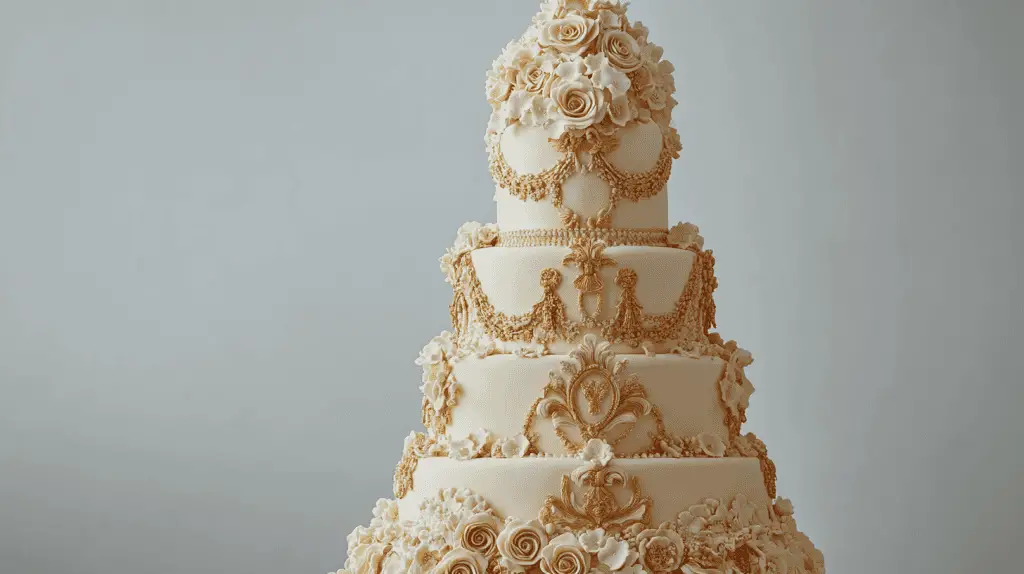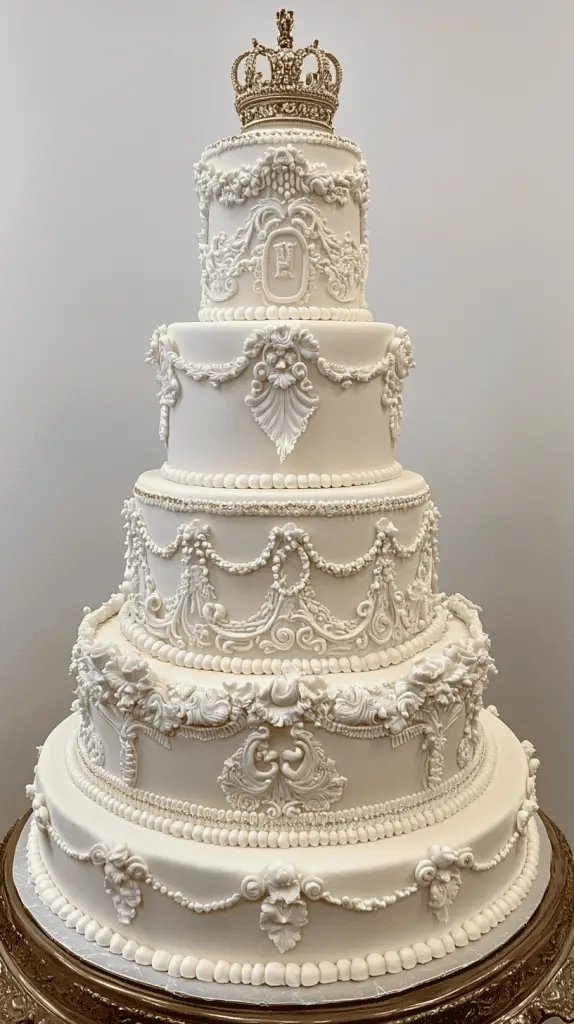Wedding cakes fit for royalty are genuine culinary masterpieces. thay embody the grandeur and elegance befitting such crucial events. These cakes frequently boast complex designs and impressive size. They frequently enough include multiple tiers and striking embellishments.
Royal weddings have always been trendsetters, influencing bakers globally. Each cake is a unique narrative, showcasing the couple’s character and the cultural spirit of their time.
Queen Victoria and Prince Albert’s 1840 wedding featured one of the first royal wedding cakes. This enormous cake had three tiers and weighed a staggering 300 pounds. Fruitcake, frequently enough used as a base, was chosen for its richness and strength to support complex designs.
Think about Prince William and Catherine Middleton’s 2011 wedding cake. It had eight impressive tiers and 900 delicate sugar flowers. The cake perfectly combined classic and contemporary styles.
Royal wedding cakes are known for their rich flavors and high-quality ingredients. They feature detailed decorations, such as flowers and edible gold. These cakes symbolize tradition,continuity,and joyful festivity during meaningful royal occasions.
The History of Royal wedding Cakes

Wedding cakes for royalty are traditionally extravagant and luxurious. Their elaborate designs and impressive height emphasize the importance of the royal celebration.
In 1840, Queen Victoria and prince Albert celebrated their marriage with a grand, three-tiered wedding cake. It weighed approximately 300 pounds. This impressive cake established a new standard for royal wedding cakes,characterized by opulent and elaborate designs.
Princess Elizabeth and the Duke of Edinburgh’s 1947 wedding boasted an amazing nine-foot-tall cake. Known as the ”10,000-mile cake,” its ingredients came from across the British Empire. This highlighted the Empire’s size and the meaning of their marriage.
Years later, in 1981, Prince Charles and Lady Diana Spencer’s wedding cake became legendary. A famous bakery created this five-tiered masterpiece. It symbolized the royal family’s romance and embrace of modern times.
The 2011 wedding cake for Prince William and Kate Middleton signaled a revival of classic wedding aesthetics. This magnificent six-tiered creation boasted intricate floral designs and a subtle,elegant color scheme. Its sophisticated beauty truly captured the world’s attention.
Royal wedding cakes have transformed over time, mirroring evolving tastes and cultural trends.More than just desserts, these cakes are historical symbols. They reflect both the period and the unique character of the royal couple.
The Symbolism Behind Royal Wedding Cake Designs

Royal wedding cakes are rich in symbolic meaning, embodying the event’s grandeur and traditions. tiered layers are a common feature, adding visual magnificence and representing the elevated status of royal occasions. Each tier signifies increasing influence, with the top tier symbolizing ultimate power and prestige.
Majestic cakes often feature floral designs. These floral decorations are more than just pretty; they carry significant symbolic weight.popular flower choices include roses, lilies, and orange blossoms. These symbolize love,wealth,purity,and fresh starts,mirroring the essence of marriage.
Royal wedding cake flavors are steeped in tradition. Fruitcake is a popular, time-honored choice. Its long shelf life represents a lasting and enduring marriage. Often,pieces are kept as souvenirs or given to guests well after the celebration.
Royal cakes boast elaborate designs. Embellishments such as shields or family crests symbolize the ancestry and heritage of the families. These details highlight the significance of tradition and the joining of two families, emphasizing the union that marriage represents.
In essence, each element of a royal wedding cake tells a story. It honors the event, the couple’s journey, and their shared history.
1. 57 Royal wedding Cake Themes & Ideas

Wedding cakes fit for royalty embody tradition, grace, and skilled craftsmanship. These stunning creations,from timeless classics to contemporary masterpieces,are visually striking and delicious.
2. Classic Royal-Inspired Cakes: Regal Tiers and white Fondant

Conventional royal wedding cakes are the epitome of elegance and heritage. They typically boast several layers, representing importance and scale. A smooth, white fondant is a popular choice for the base, creating a refined and enduring aesthetic. This style evokes memories of previous royal celebrations, which have long defined luxury.
Adding white and gold or silver details amplifies the cake’s grandeur. Complex designs and delicate piping showcase the baker’s talent, resulting in a truly memorable focal point.
3. Floral Adornments: Roses, Peonies, and English Garden Themes

Wedding cakes adorned with floral designs exude grace and organic charm.Popular choices include roses,peonies,and various other blossoms. These floral accents,whether fresh or meticulously crafted from sugar,introduce a refined and personalized element.
These creations frequently draw inspiration from classic English gardens. Expect abundant foliage and delicate pastel flowers decorating each tier. These designs create an atmosphere of romance and enduring elegance.
4. Gold Leaf Accents for a Luxurious Touch

Gilded accents elevate a royal wedding cake to new heights of luxury. Thin sheets of gold can be carefully placed to accentuate details or generously draped over layers for a truly extravagant look. The shimmering gold beautifully contrasts with white or soft-colored frosting, resulting in a majestic and rich aesthetic.
to elevate the cake’s regal appearance, consider pairing gold details with floral patterns or personalized monograms. This combination creates a truly luxurious and royal-worthy dessert.
5. Crown-Topped Cakes: fit for Royalty

Royal wedding cakes look magnificent with crown toppers. These elegant decorations honor tradition and royalty. Crafted from sugar or fondant, crowns create a refined and cohesive theme.
Crown-topped cakes embody grandeur and tradition, creating a breathtaking visual impact. When combined with rich colors or elaborate designs, they perfectly capture the essence of royal elegance.
6. Royal Monograms and Personalized Emblems

adding royal monograms or emblems makes the cake unique. It brings a sense of history and personal identity. Skilled piping or embossing creates these design elements on the cake. This personalization is a classic tradition. It represents the couple’s heritage and bond.
These symbols can be carefully positioned on different levels. They add sophistication without making the design feel cluttered.
7. Fruitcake: The Traditional Royal Wedding Flavor

Fruitcake is a classic choice for royal weddings. Its dense, rich texture, combined with fruits and nuts, offers a delightful taste. the cake’s ability to last long makes it perfect for these grand celebrations.
This timeless dessert boasts a rich history. It symbolizes enduring tradition and offers a canvas for stunning embellishments. Despite newer trends, fruitcake continues to be a beloved centerpiece at royal celebrations.
8. modern Takes on Royal Wedding Cakes

Today’s royal cakes showcase exciting new tastes and creative designs. They remain elegant but might include bright colors or unusual forms. Marbled fondant or striking shades add a modern touch to the classic royal cake.
Finding the right mix of time-honored customs and personal style is essential.The wedding cake should reflect the couple’s wishes while respecting royal traditions.
9. Tall and Majestic: the Grandeur of Multi-Tiered Cakes

Royal celebrations often feature magnificent, multi-tiered cakes. These towering desserts represent both splendor and aspiration. Each layer can showcase a unique flavor or design, enabling creative expression within a unified concept.
Its impressive height and design evoke a sense of celebration,creating a captivating centerpiece. This grand scale requires careful construction to ensure both beauty and structural integrity.
10. Royal Cake Toppers and Accessories

Royal wedding cakes gain individuality through toppers and accessories.Rather of just crowns, consider meaningful figures or bespoke designs. These delicate additions personalize the cake, emphasizing its importance.

